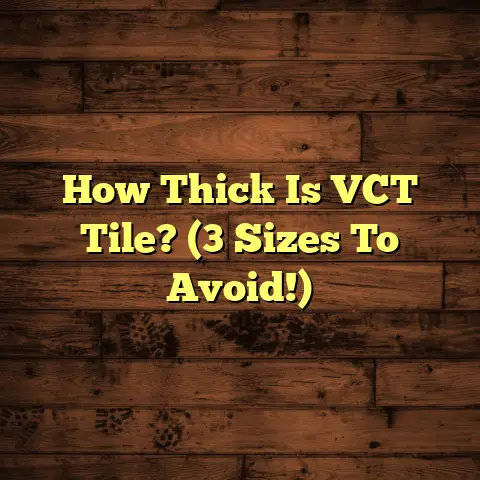Why Is My Engineered Wood Floor Buckling? (Explained)
I’ve always been eco-conscious, striving to make choices that not only benefit my family but also the environment.
As a flooring contractor, I take pride in working with sustainable materials, and engineered wood flooring has been one of my go-to options.
However, I’ve encountered issues along the way, particularly with buckling.
Let me share my journey and insights on why engineered wood floors buckle and how to address this frustrating problem.
Understanding the Causes of Buckling
Buckling can be a real headache.
It’s when the boards lift and create uneven surfaces, making your beautiful floor look warped.
The causes of buckling can range from environmental factors to improper installation.
1. Humidity and Moisture Issues
One of the most common culprits behind buckling is excessive moisture.
Engineered wood flooring is designed to withstand some level of humidity, but too much can lead to problems.
I remember a project in a lovely coastal home where the humidity levels were consistently high.
Despite the homeowner’s efforts to run dehumidifiers, the floor started to buckle within months of installation.
The humidity levels in a home can fluctuate due to various factors, including weather changes, indoor activities like cooking or showering, and even the type of heating or cooling systems used.
For example, homes without proper ventilation can trap moisture, leading to unmanageable humidity levels that affect flooring.
Solutions:
- Humidity Control: Use dehumidifiers in areas prone to moisture.
I recommend setting them to maintain humidity levels between 30% and 50%.
This range is optimal for most engineered wood floors. - Acclimation: Always allow the flooring to acclimate in the space before installation.
This means letting the planks sit in the room for at least 48 hours.
It helps the wood adjust to the temperature and humidity of its new environment.
2. Improper Installation
I’ve seen firsthand how crucial proper installation is.
Skipping steps or not following manufacturer guidelines can lead to significant issues.
During one of my early projects, I neglected to leave expansion gaps around the perimeter of the room.
As a result, the flooring expanded with seasonal changes, leading to buckling.
It’s vital to remember that engineered wood is made up of multiple layers, which can expand and contract differently than solid wood.
If not installed correctly, these differences can lead to stress on the boards.
Solutions:
- Leave Expansion Gaps: Always leave at least a quarter-inch gap around walls and fixed objects like cabinets or pipes.
This allows for natural movement of the floor. - Follow Manufacturer Guidelines: Adhere strictly to installation instructions provided by the manufacturer.
Each product may have specific requirements based on its construction.
3. Subfloor Problems
The condition of the subfloor is another critical factor.
A damaged or uneven subfloor can cause engineered wood to buckle over time.
I recall working on a job where the homeowner had installed new flooring over an old, uneven concrete slab without addressing the level issues first.
It didn’t take long for the floor to start buckling.
A subfloor that isn’t level can cause high spots and low spots, which puts pressure on the flooring above it.
This pressure can lead to warping and buckling if not corrected before installation.
Solutions:
- Inspect Subfloor: Always check for damage and levelness before installation.
A simple level tool can help identify areas that need adjustment. - Use Underlayment: Consider using an appropriate underlayment to create a smoother surface.
This not only helps with leveling but also provides additional moisture protection.
4. Temperature Fluctuations
Temperature changes can also contribute to buckling in engineered wood floors.
When temperatures rise, materials can expand; when they drop, they contract.
This natural movement can lead to buckling if there isn’t enough space for expansion.
I’ve worked in homes with radiant heating systems where fluctuations in temperature were frequent, leading to challenges in maintaining floor integrity.
Solutions:
- Maintain Consistent Temperature: Keeping your home’s temperature stable can help minimize expansion and contraction.
- Use Radiant Heating Systems Cautiously: If installing over radiant heat, ensure that the flooring is rated for such systems and that you follow specific guidelines for installation.
5. Water Damage
One of my worst experiences involved water damage from a leaky pipe.
The homeowner hadn’t noticed it until it was too late, resulting in significant buckling across several boards.
Water can seep into engineered wood flooring through joints or if it’s left standing on the surface.
Solutions:
- Immediate Cleanup: If water spills occur, clean them up immediately to prevent moisture absorption.
- Regular Inspections: Check plumbing fixtures regularly for leaks and address any signs of water damage promptly.
Recognizing Signs of Buckling
It’s essential to catch issues early before they escalate.
Here are some signs that your engineered wood floor might be buckling:
- Visible Gaps: Gaps between boards can indicate that they’re shifting due to expansion or contraction.
- Cupping or Crowning: If the edges of boards are lifting (cupping) or if they’re higher in the center (crowning), it’s a sign of moisture issues.
- Uneven Surfaces: Walk across your floor; any noticeable bumps or dips should raise concerns.
Taking action at the first sign of buckling can save both time and money down the road.
My Experience with Cost Estimation
When it comes to addressing buckling, cost estimation is critical.
While tackling these issues can be costly, having accurate estimates allows me to work within budget constraints.
I’ve found that using FloorTally helps streamline this process.
It pulls local material and labor rates, so I can provide clients with realistic budgets quickly.
For instance, during a recent project where buckling needed addressing, I was able to estimate costs for repairs effectively.
This included removing and replacing damaged boards, which could have easily escalated without proper budgeting.
Comparing Solutions
In my experience, I’ve encountered various solutions for buckled floors:
- Repairing vs.
Replacing: Sometimes, it’s possible to repair damaged sections by replacing individual boards.
Other times, a complete replacement may be necessary, especially if extensive damage has occurred. - Professional Help vs.
DIY: While some homeowners opt for DIY repairs, I’ve found that hiring professionals often leads to better results, especially with tricky issues like subfloor problems.
While DIY repairs can save money upfront, they may not always yield the same quality as professional work.
I’ve seen DIY projects go awry due to lack of experience or knowledge about materials.
Tips and Advice for Maintenance
To prevent buckling from happening in the first place, I recommend regular maintenance:
- Control Humidity Levels: Invest in a quality hygrometer to monitor indoor humidity.
Keeping levels between 30% and 50% is ideal. - Routine Inspections: Periodically inspect your flooring for signs of wear or damage.
Early detection can prevent larger problems. - Prompt Repairs: Address any water leaks or spills immediately to prevent moisture buildup.
Additional Maintenance Tips
- Regular Cleaning: Use a damp mop or cloth regularly instead of soaking wet mops which can introduce moisture.
- Avoid Excessive Water: Be cautious with wet cleaning methods; always wring out mops thoroughly.
- Use Protective Pads: Place protective pads under furniture legs to prevent scratches and dents that can complicate potential buckling issues.
Analyzing Different Flooring Options
Choosing between engineered wood flooring and other options like solid hardwood or laminate involves weighing each choice’s pros and cons based on your specific needs.
Engineered Wood vs. Solid Hardwood
- Durability: Engineered wood tends to be more resistant to moisture compared to solid hardwood but may not have the same lifespan if subjected to extreme conditions.
- Cost: Generally, engineered wood is more affordable than solid hardwood but offers similar aesthetics.
- Installation: Engineered wood is often easier to install due to its click-lock design while solid hardwood requires more intricate installation techniques.
Engineered Wood vs. Laminate
- Appearance: Engineered wood provides a more authentic look compared to laminate due to its real wood surface.
- Moisture Resistance: Laminate is often more resistant to water damage but lacks the natural feel of wood.
- Maintenance: Both options require similar maintenance practices; however, laminate’s surface is typically easier to clean.
Ultimately, choosing the right flooring involves weighing these factors against your specific needs and environment.
Conclusion: A Comparative Analysis
When considering options for flooring, engineered wood has its pros and cons compared to solid hardwood or laminate.
Engineered wood offers stability in varying conditions but requires careful attention to installation and environmental factors.
In my experience, solid hardwood tends to be more durable but can be prone to warping in humid conditions unless properly sealed.
Laminate is generally more resistant to moisture but lacks the natural beauty of wood.
Ultimately, choosing the right flooring involves weighing these factors against your specific needs and environment.
Remember that prevention is key; staying proactive about maintenance can save you time and money down the line.
If you ever find yourself facing buckling issues with your engineered wood floor, don’t hesitate to reach out for help!
It’s always better to address these problems sooner rather than later.
Final Thoughts
Having worked with various flooring types over the years, I’ve learned valuable lessons about maintenance, installation practices, and how environmental factors play significant roles in preserving flooring integrity.
Investing time into understanding how your flooring reacts under different conditions will pay off immensely in extending its lifespan and maintaining its beauty.
So next time you walk across your engineered wood floor, take a moment to appreciate it while being mindful of how you care for it!
Your efforts will surely enhance its charm and durability for years to come.





